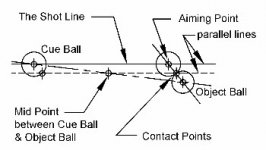cuetechasaurus said:This is like blasphemy....saying the "pros" use aiming systems, as if you speak for all of them. Not many of them do, and the ones that do, use aiming systems for tough shots. Everything else, they don't need aiming systems, because they arent newbies that arent sure where to aim like you.
You mean you didn't know?
The pros all use the same secret aiming system. Balls splitting the pockets all over the place pretty much proves that. They won't tell us about it because then they'd either have to kill us or let us be pros too.
They hold this information as tightly as the government and pharmeceutical industry hold on to the natural cures for cancer and the common cold....
mike page
fargo
